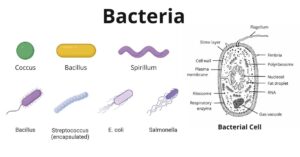Bacteria are a type of simple, microscopic, unicellular organism. In 1675, Dutch scientist A. van Leeuwenhoek was first discovered bacteria. He proved the existence of bacteria in his own made microscope and named them animalcules.
Later, French scientist Louis Pasteur and German scientist Robert Koch proved through various experiments that bacteria are the cause of various diseases in plants and animals.
Ehrenberg first introduced the term bacteria in 1828. The French surgeon Sedillot (1878) called them the microbes.

Introduction
Bacteria are the simplest microscopic organisms in the living world. They do not have a well-organized nucleus and membrane surrounding cellular organelles. Also, 70s type ribosomes are present in the cell.
Previously, bacteria were considered animals due to the presence of cilia in some of them. Later, they were included in the plant kingdom because of the cell wall present in the bacterial cell, like plant cell.
In modern times, bacteria are considered to belong to a separate kingdom called the Protista. They are called Protista because they are similar to unicellular fungal yeast and unicellular protozoa.
Definition of Bacteria
Bacteria are unicellular, simplest, microscope organisms containing the primitive nucleus and cell wall.
Characteristics of Bacteria
The characteristics of bacteria are as follows:
- Bacteria are the smallest and simplest microbes in cellular organisms.
- They are mostly unicellular, very few are mycelial or colonial, or filamentous.
- They may be motile or non-motile. In motile bacteria, flagella are present.
- The protoplasm consists primitive type of nucleus. The nucleus does not have a nuclear membrane, nucleolus, or nuclear reticulum and also, contains only a spiral double-stranded DNA fiber.
- Bacterial DAN is called nucleoid or genophore.
- The protoplasm contains 70s type of ribosomes and mesosomes. Also, there are no membrane-bound cell organelles (like plastids, mitochondria, ER, etc.) in the bacterial protoplasm.
- Bacterial cells have a well-formed cell wall outside the cell membrane.
- The cell wall is made up of peptidoglycan or mucopeptide.
- Most of the bacteria are heterotrophic, and some are autotrophic.
- In autotrophs, various types of photosynthetic pigments (like bacteriochlorophyll, bacterioviridin, and carotenoids) are present in their bodies.
- Bacteria are both anaerobes and aerobes.
- They can survive at temperatures of 70°C to 80°C.
- In the absence of chromosomes, bacterial mitosis and meiosis cell division do not occur.
- They can be reproduced by vegetative, asexual, and sexual methods.
- Asexual reproduction is mainly binary fission.
- Sexual reproduction is of a special type – gene recombination takes place by conjunction, transformation, and transduction.
- Bacteria can synthesize vitamins. A few of them can fix atmospheric nitrogen.
- They accumulate energy by oxidizing salt.
- They play an important role in maintaining the fertility of the soil.
- A few bacteria are important for their production of antibiotics and alcohol.
- They cause various diseases in plants, animals, and humans.
Examples of Bacteria
Some common bacterial species are Diplococcus, Bacillus, Salmonella sp, Mycobacterium sp, Spirillum, Nitrosomonas, Rhizobium, Chlorobium, etc.



